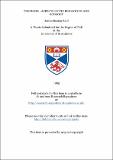Files in this item
The rook : aspects of its behaviour and ecology
Item metadata
| dc.contributor.author | Reid, James Beaton | |
| dc.coverage.spatial | 354 p. | en_US |
| dc.date.accessioned | 2018-07-06T14:09:36Z | |
| dc.date.available | 2018-07-06T14:09:36Z | |
| dc.date.issued | 1985 | |
| dc.identifier.uri | https://hdl.handle.net/10023/15062 | |
| dc.description.abstract | Aspects of the ecology and behaviour of the rook Corvus frugilegus L. were studied. The decline of rook populations in Britain since the 1940's is documented and the extent and reasons for the decline in north east Fife examined in detail. The most likely causes of this were changes in agricultural practices, including the way the land is used and possibly the use of organo-chlorine insecticides. The ecological relationship between the rook and the carrion crow C. corone L. is explored in an investigation of their habitat use and associated niche metrics. Both species are heavily dependent on agricultural land, especially grassland, for foraging. The carrion crow narrows its niche breadth more than the rook does at times of possible food shortage. Observations on captive birds show rooks to be subordinate to carrion crows. Analysis of nestling rook gizzard contents revealed cereal to be an abundant food as well as invertebrates, particularly beetles and tipulids. A review of tool-use in birds is presented and the conditions under which tool-use is likely to arise are elucidated. The proximate causation of an example of this category of behaviour performed by at least one captive rook is reported. The rook is identified as an ecologically and behaviourally adaptable bird. | en_US |
| dc.language.iso | en | en_US |
| dc.publisher | University of St Andrews | |
| dc.subject.lcc | QL696.P2367R3 | en |
| dc.subject.lcsh | Corvidae | en |
| dc.title | The rook : aspects of its behaviour and ecology | en_US |
| dc.type | Thesis | en_US |
| dc.type.qualificationlevel | Doctoral | en_US |
| dc.type.qualificationname | PhD Doctor of Philosophy | en_US |
| dc.publisher.institution | The University of St Andrews | en_US |
This item appears in the following Collection(s)
Items in the St Andrews Research Repository are protected by copyright, with all rights reserved, unless otherwise indicated.

